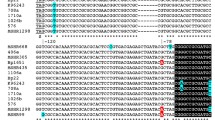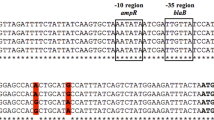Summary
The previously cloned class A β-lactamase gene (bla) of Streptomyces cacaoi was shown to be inducible by β-lactam compounds in the host organism S. lividans. A regulatory region of 2.75 kb was identified and the nucleotide sequence determined. It contained four open reading frames (ORFs) of which only two were complete and required for induction. ORF1-ORF2 exerted a positive regulatory effect on the expression of bla. Inactivation of ORF1 or of ORF2 resulted not only in the loss of induction, but also in a 30- to 60-fold decrease in the basal (non-induced) level of β-lactamase production. ORF1 codes for a DNA-binding protein related to the AmpR repressor/activator, which controls the expression of ampC (class C β-lactamase) genes in several Enterobacteria.
Similar content being viewed by others
References
Ansorge W, Sproat B, Stegemann J, Schwager C, Zenke M (1987) Automated DNA sequencing: ultrasensitive detection of fluorescent bands during electrophoresis. Nucleic Acids Res 15:4593–4602
Boyer HW, Roulland-Dussoix D (1969) A complementation analysis of the restriction and modification of DNA in Escherichia coli. J Mol Biol 41:459–472
Campbell JIA, Scahill S, Gibson T, Ambler RP (1989) The phototrophic bacterium Rhodopseudomonas capsulata sp108 encodes an indigenous class A β-lactamase. Biochem J 260:803–812
Chang ACY, Cohen SN (1978) Construction and characterization of amplifiable multicopy DNA cloning vehicles derived from the P15A cryptic miniplasmid. J Bacteriol 134:1141–1156
Chang M, Hadero A, Crawford IP (1988) Sequence of the Pseudomonas aeruginosa trpI activator gene and relatedness of trpI to other prokaryotic regulatory genes. J Bacteriol 171:172–183
Dehottay P, Dusart J, Duez C, Lenzini MV, Martial JA, Frere JM, Ghuysen JM, Kieser T (1986) Cloning and amplified expression in Streptomyces lividans of a gene encoding extracellular β-lactamase from Streptomyces albus G. Gene 42:31–36
Devereux J, Haeberli P, Smithies O (1984) A comprehensive set of sequence analysis programs for the VAX. Nucleic Acids Res 12:387–395
Egelhoff TT, Fisher RF, Jacobs TW, Mulligan JT, Long SR (1985) Nucleotide sequence of Rhizobium meliloti 1021 nodulation genes: nodD is read divergently from nodABC. DNA 4:241–248
Forsman M, Lindgren L, Häggström B, Jaurin B (1989) Transcriptional induction of Streptomyces cacaoi β-lactamase by a β-lactam compound. Mol Microbiol 3:1425–1432
Gaboriaud C, Bissery V, Bencheritt T, Mornon JP (1987) Hydrophobic cluster analysis: an efficient new way to compare and analyse amino acid sequences. FEBS Lett 224:149–155
Goad WB, Kanehisa MI (1982) A general method for finding local homologies and symmetries. Nucleic Acids Res 10:247–263
Henikoff S, Haughn GW, Calvo JM, Wallace JC (1988) A large family of bacterial activator proteins. Proc Natl Acad Sci USA 85:6602–6606
Henrissat B, Saloheimo M, Lavaitte S, Knowles JKC (1990) Structural homology among the peroxidase enzyme family revealed by hydrophobic cluster analysis. Proteins Struct Funct Genet 8:251–257
Herzberg O, Moult J (1987) Bacterial resistance to β-lactam antibiotics: crystal structure of β-lactamase from Staphylococcus aureus PC1 at 2.5 A resolution. Science 236:694–701
Himeno T, Imanaka T, Aiba S (1986) Nucleotide sequence of the penicillinase repressor gene penI of Bacillus licheniformis and regulation of penP and penI by the repressor. J Bacteriol 168:1128–1132
Honoré N, Nicolas MH, Cole ST (1986) Inducible cephalosporinase production in clinical isolates of Enterobacter cloacae is controlled by a regulatory gene that has been deleted from Escherichia coli. EMBO J 5:3709–3714
Hopwood DA, Kieser T, Wright HM, Bibb MJ (1983) Plasmids, recombination and chromosome mapping in Streptomyces lividons 66. J Gen Microbiol 129:2257–2269
Hopwood DA, Bibb MJ, Chater KF, Kieser T, Bruton CJ, Kieser HM, Lydiate DJ, Smith CP, Ward JM, Schrempf H (1985) Genetic manipulation of Streptomyces. A laboratory manual. The John Innes Foundation, Norwich, UK
Joris B, Ghuysen JM, Dive G, Renard A, Dideberg O, Charlier P, Frere JM, Kelly JA, Boyington JC, Moews PC, Knox JR (1988) The active-site-serine penicillin-recognizing enzymes as members of the Streptomyces R61 DD-peptidase family. Biochem J 250:313–324
Katz E, Thompson CJ, Hopwood DA (1983) Cloning and expression of the tyrosinase gene from Streptomyces antibiotics in Streptomyces lividans. J Gen Microbiol 129:2703–2714
Kelly JA, Dideberg O, Charlier P, Wéry JP, Libert M, Moews PC, Knox JR, Duez C, Fraipont C, Joris B, Dusart J, Frere JM, Ghuysen JM (1986) On the origin of bacterial resistance to penicillin: comparison of a β-lactamase and a penicillin target. Science 231:1429–1431
Kobayashi T, Zhu YF, Nicholls NJ, Lampen JO (1987) A second regulatory gene, blaRI, encoding a potential penicillin-binding protein required for induction of β-lactamase in Bacillus licheniformis. J Bacteriol 169:3873–3878
Lampen JO, Nicholls NJ, Salerno AJ, Grossman MJ, Zhu YF, Kobayashi T (1988) Induction of β-lactamase in Bacillus spp.: From penicillin-binding to penicillinase. In: Actor P, DaneoMoore L, Higgins ML, Salton MRJ, Shockman GD (eds) Antibiotic inhibition of bacterial cell surface assembly and function. American Society for Microbiology, Washington DC, pp 481–487
Lenzini MV, Nojima S, Dusart J, Ogawara H, Dehottay P, Frere JM, Ghuysen JM (1987) Cloning and amplified expression in Streptomyces lividans of the gene encoding the extracellular β-lactamase from Streptomyces cacaoi. J Gen Microbiol 133:2915–2920
Lenzini MV, Ishihara H, Dusart J, Ogawara H, Joris B, Van Beeumen J, Frere JM, Ghuysen JM (1988) Nucleotide sequence of the gene encoding the active-site serine β-lactamase from Streptomyces cacaoi. FEMS Microbiol Lett 49:371–376
Lenzini MV, Piron-Fraipont C, Royen-Quittre V, Van Steeger H, Dusart J (1991) Induction of the β-lactamase gene in Streptomyces cacao. Arch Int Physiol Biochem Biophys 99: B66
Lindberg F, Westman L, Normark S (1985) Regulatory components in Citrobacter freundii ampC β-lactamase induction. Proc Natl Acad Sci USA 82:4620–4624
Lindberg F, Lindquist S, Normark S (1988) Molecular mechanism of β-lactamase induction. In: Actor P, Daneo-Moore L, Higgins ML, Salton MRJ, Shockman GD (eds) Antibiotic inhibition of bacterial cell surface assembly and function. American Society for Microbiology, Washington DC, pp 488–493
Lindquist S, Lindberg F, Normark S (1989) Binding of the Citrobacter freundii AmpR regulator to a single DNA site provides both autoregulation and activation of the inducible ampC β-lactamase gene. J Bacteriol 171:3746–3753
Lodge JM, Minchin SD, Piddock LJV, Busby SJW (1990) Cloning, sequencing and analysis of the structural gene and regulatory region of the Pseudomonas aeruginosa chromosomal ampC β-lactamase. Biochem J 272:627–631
Maniatis T, Fritsch EF, Sambrook J (1982) Molecular cloning: a laboratory manual. Cold Spring Harbor Laboratory, Cold Spring Harbor, NY
Matagne A, Misselyn-Bauduin AM, Joris B, Erpicum T, Granier B, Frère JM (1990) The diversity of the catalytic properties of class A β-lactamases. Biochem J 265:131–146
O'Callaghan CH, Morris A, Kirby SM, Shingler AH (1972) Novel method for detection of β-lactamases by using a chromogenic cephalosporin substrate. Antimicrob Agents Chemother 1:283–288
Oefner C, d'Arcy A, Daly JJ, Gubernator K, Charnas RL, Heinze I, Hubschwerlen C, Winkler FK (1990) Refined crystal structure of β-lactamase from Citrobacter freundii indicates a mechanism for β-lactam hydrolysis. Nature 343:284–288
Oliva B, Bennett PM, Chopra I (1989) Penicillin-binding protein 2 is required for induction of the Citrobacter freundii class I chromosomal β-lactamase in Escherichia coli. Antimicrob Agents Chemother 33:1116–1117
Rowland SJO, Dyke KGH (1989) Characterization of the staphylococcal β-lactamase transposon Tn552. EMBO J 8:2761–2773
Samraoui B, Sutton BJ, Todd RJ, Artymiuk PJ, Waley SG, Phillips DC (1986) Tertiary structural similarity between a class A β-lactamase and a penicillin-sensitive D-alanyl-carboxypeptidasetranspeptidase. Nature 320:378–380
Sanger F, Nicklen S, Coulson AR (1977) DNA sequencing with chain-terminating inhibitors. Proc Natl Acad Sci USA 74:5463–5467
Sanger F, Coulson AR, Barnell BG, Smith AJH, Roe BA (1980) Cloning in single-stranded bacteriophage as an aid to rapid DNA sequencing. J Mol Biol 143:161–178
Staden R (1984) Measurements of the effects that coding for a protein has on a DNA sequence and their use for finding genes. Nucleic Acids Res 12:551–567
Staden R, McLachlan AD (1982) Codon preference and its use in identifying protein coding regions in long DNA sequences. Nucleic Acids Res 10:141–156
Urabe H, Lenzini MV, Mukaide M, Dusart J, Nakano MM, Ghuysen JM, Ogawara H (1990) β-Lactamase expression in Streptomyces cacaoi. J Bacteriol 172:6427–6434
Waley SG (1988) β-Lactamases: a major cause of antibiotic resistance. Sci Progr (Oxf) 72:579–597
Ward JM, Janssen GR, Kieser T, Bibb MJ, Buttner MJ, Bibb MJ (1986) Construction and characterization of a series of multi-copy promoter-probe plasmid vectors for Streptomyces using the amino-glycoside phosphotransferase gene from Tn5 as indicator. Mol Gen Genet 203:468–478
Wek RC, Hatfield GW (1986) Nucleotide sequence and in vivo expression of the ilvY and ilvC genes in Escherichia coli. Transcription from divergent overlapping promoters. J Biol Chem 261:2441–2450
Zhu YF, Curran IHA, Joris B, Ghuysen JM, Lampen JO (1990) Identification of B1aR, the signal transducer for β-lactamase production in Bacillus licheniformis, as a penicillin-binding protein with strong homology to the OXA-2 β-lactamase (class D) of Salmonella typhimurium. J Bacteriol 172:1137–1141
Author information
Authors and Affiliations
Additional information
Communicated by W. Goebel
Rights and permissions
About this article
Cite this article
Lenzini, V.M., Magdalena, J., Fraipont, C. et al. Induction of a Streptomyces cacaoi β-lactamase gene cloned in S. lividans . Molec. Gen. Genet. 235, 41–48 (1992). https://doi.org/10.1007/BF00286179
Received:
Accepted:
Issue Date:
DOI: https://doi.org/10.1007/BF00286179




